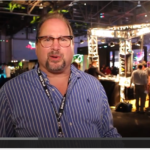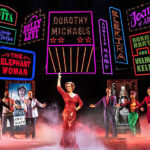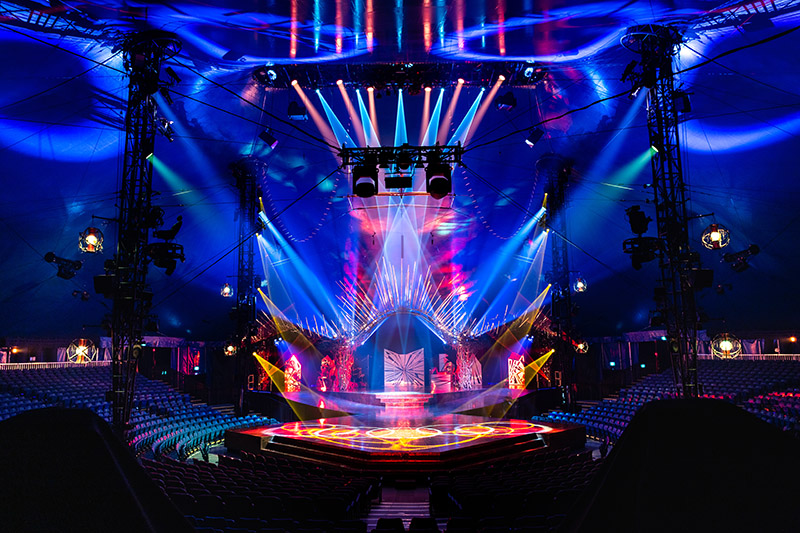
LD Mikki Kunttu Ensures the Classic Shines in a Truly New Light
Not many shows can boast the global reach that Cirque du Soleil’s iconic Alegría has had since premiering 25 years ago. First presented in 1994, Alegría debuted in Montreal’s Old Port before embarking on tour for 15 years under the Big Top and then four more years in its arena version. Alegría visited 255 cities around the world over 19 years during which it was performed more than 6,600 times in front of over 14 million spectators in 40 countries before taking a final bow at the end of 2013.
The original show not only helped define the company’s signature style, but also paved the way for its worldwide expansion. In celebration of its 25th anniversary, Alegría is once again playing at Montreal’s Old Port, where it opened this past April before setting out on a Big Top tour in August. Having been reinterpreted for modern audiences, this renewed version still shares its story of “the quest for power, the thirst for change, and the triumph of light over darkness” — timeless and ever relevant themes.

Same Show, New Lens
Now billed as Alegría—In a New Light, the tagline captures perfectly the approach taken for this new production. Wanting to, as Cirque du Soleil states, “revisit the show through today’s lens to ensure it is as inspiring as it was 25 years ago,” the creative team is a mix of original and new people. Dominique Lemieux, the show’s original costume designer, and Nathalie Gagné, original makeup designer, revisit their own iconic work, while welcoming set and props designer Anne-Séguin Poirier and lighting designer Mikki Kunttu.
Mikki Kunttu, a Finnish lighting, screens, and set designer, has worked throughout the Scandinavian countries as well as the rest of Europe and the U.S. His impressive list of credits cover opera, ballet, contemporary dance, television, concerts, live events [including Eurovision in 2007 (Finland) and 2013 (Sweden)] and now, the circus. Having decided to relocate to Montreal this past year, Kunttu started talking with Cirque du Soleil about possible projects, and as he notes, “It was the perfect timing for me when they proposed Alegría.”
Not bound by recreating the original design but asked instead to take the opportunity to do something completely new, Kunttu describes his approach. “For me it’s like when I work on different versions of an opera. The core of the show is still the same, but the version is visually different. This production is entirely different in terms of lighting from the original; we started from a clean state. I try to start from a clean slate, so I can find what is the core in the production, what is the essence of it, and work from there, and get inspired.
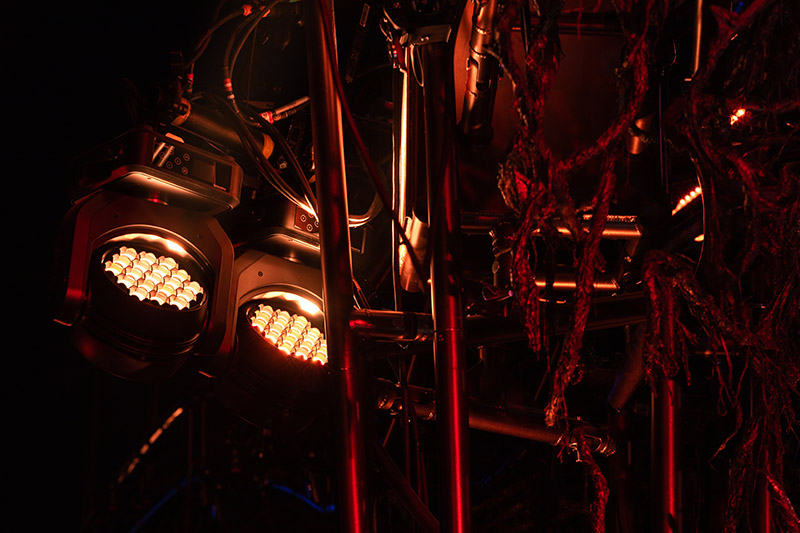
1994 vs. 2019
“Things are different than when this piece was created in 1994, especially visually, we are living in completely different times. I strongly believe in the power of theater, and the power of having the performer and the audience, the lighting, and the music and everything in the same space. I think it’s still the core of everything we do. The interaction between the performer, the talent on stage, and the audience. That’s what we’re trying to support.”
Working closely with Kunttu was Cirque du Soleil’s Christian Blais, lighting project manager on Alegría, to ensure the designer’s vision was realized. “My role is to receive the lighting design and then make sure everything runs smoothly and finishes on time.” To accomplish this Blais knew he could rely upon Solotech as the lighting supplier. “I talked with Solotech, with whom Cirque du Soleil has been working with for about 35 years, and I’ve always had great service from them. I worked with Mathieu Taillon [major account manager] there and talked to him about the range of products that Mikki and I would like to see, he setup the tests for us and then Mikki identified the products of his choice.”
Seeing the range of, as well as the newest, lighting products available and testing options was essential as Kunttu had decided to use an all LED lighting rig for Alegría, except for the Robert Juliat followspots. He wanted to leverage the most current technology available both economically, environmentally, and creatively. “LED brings us more of a palette,” the designer notes. “I mostly enjoy the richness of colors, and the possibilities that LED brings. Lighting is truly one of the main components of the atmosphere of a show and the possibilities are endless compared to 20 years ago as the products have evolved so much. I wanted to have great quality products to really support the show, and LED fixtures were essential for that.”
Taillon, after speaking with Blais, gathered the lights that would be compatible with effects desired by the designer and the type of fixtures Kunttu wanted in the plot. He set up testing in Solotech’s studio in Montreal’s downtown Ville-Marie district. “We tested fixtures for two days, in different environments, with and without smoke,” says Taillon. “Mikki came in with Christian and they compared the dimming curve, the colors, all the fixtures, the sizes, the spots and wash lights, the harmony of the colors from different products. It was really useful to do the testing. I was pleased that as Solotech we were able to facilitate the testing they needed to see so that they could select the right fixtures for the design.” The selection was heavily Ayrton, which Blais is very satisfied with, saying, “The products are great; we were very impressed.”
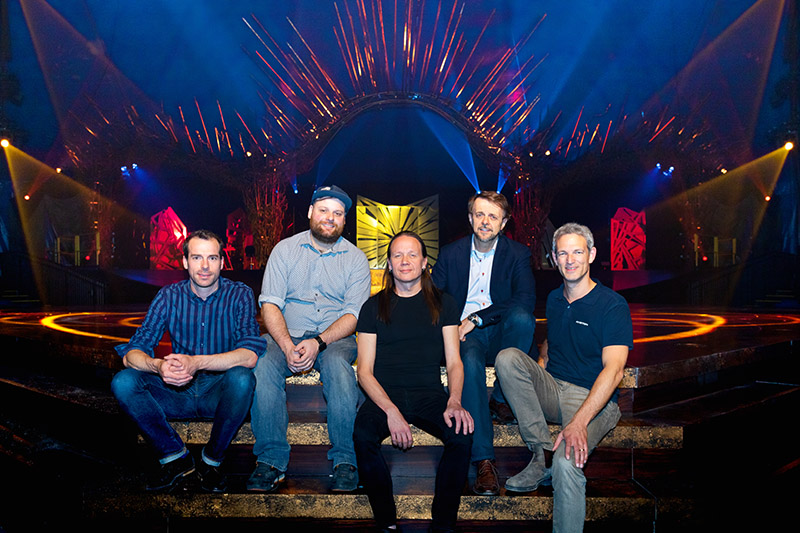
Fresh Looks
“Being an LED-based design, technology that did not exist during the first show 25 years ago, it brings a fresh new look to the show,” states Michael Althaus, Ayrton’s director of global sales. “This is a tour, so a lot of things matter. The fixtures must be small, have low power consumption and especially important is output. The Ayrton products are quite new, so with Theatrixx, our exclusive Canadian distributor, and Solotech, we participated in the testing for Mikki, and the Ayrton fixtures really delivered. He was looking for a light in this output category and with framing. Costs are so important in such a production, especially consumption costs. The Ayrton products are unique in this aspect because of their optical efficiency at the end; getting the most light output.”
As for the gear selected, the Ayrton Mistral Spot luminaires play a key role in the rig. “The Mistral was the main workhorse on this show,” says Kunttu. “With the spots, it’s essential to have enough punch, and the quality of light needs to be very good, with good colors. Then there are a couple of [Ayrton] Ghiblis [that] I used as front lights, and a couple of back light specials. The Ghibli really lets you shape the light; it’s really a fantastic spot. In this show the wash luminaires need to be highly performant. The [Ayrton] NandoBeams offer great color rending, rich saturation, high output efficiency, they’re very compact, which is great in the specific environment we’re dealing with, the tent,” Kunttu adds. (The rig includes NandoBeam S9 and S3 fixtures.) “It’s nice to have all the fixtures from Ayrton because it’s really easy to work with the color palette, everything matches nicely. You want to have a certain blue, and you have it all across the rig. I find the Ayrton products are among the first generation of LED spots that are delivering theatrical quality. This is a new generation of lighting fixtures; I would love to use them again.” Kunttu also enjoyed working with Solotech. “It was fantastic support from them and it worked out quite well.”
Fixtures chosen, Taillon oversaw Solotech’s scope of work to supply the lighting equipment package, Solotech partnered with Ayrton and Theatrixx. Solotech handled the coordination with Theatrixx to provide the products to Alegría. Theatrixx also supplied most of the power cabling and electrical distribution to the production. Taillon comments, “Theatrixx did a great job. I was really happy that they accommodated the production to maintain the quality of this show, offering really interesting options to the designer, both in terms of quality and price.”
Jacques Tessier, president of Theatrixx, was not surprised that Kunttu and Blais selected Ayrton, because, “The new Ayrton luminaires power consumption is much lower; the maintenance is considerably reduced. Another advantage is that they don’t overheat as other products do, so in a tent, during the summer, you’re going to spend much less on air conditioning.” Lowering power consumption was indeed critical to Cirque du Soleil who made the reduction of its environmental footprint a corporate social responsibility priority.
A Dynamic Palette
Kunttu very effectively uses the LED fixtures to create a dynamic palette of looks throughout Alegría, which like all Cirque du Soleil shows, has a vast range of performance types. This meant that he needed to solve the design challenge of balancing everything from small intimate stage moments to large aerial acts. “The smaller the act, the more space you have as a visual designer, so I can design around it,” says Kunttu. “The more people you have on stage, the more complex it becomes in terms of delivering a visual. It needs to be as strong as the more intimate numbers, but even just from security point of view for the acrobats, you need to light up most of the stage. That’s a practical point of view that has a big impact on the visual too.
The smaller numbers are in a way, easier to light.”
He continues, “Every number sort of found its own characteristic. During the process of rehearsals, which are slower as the acrobatics would take a lot of time for training reasons, you find the right nuances and the right colors, working together with the costume designers, the stage director, and set designer, combining each and everyone’s craft. Bringing it all in and trying to make the best look out of it, I think that’s the process really.”
An example of the success of that process for Kunttu is the moment of the snowstorm, “The snowstorm was a really interesting detail to work on in the new version, as that was one of the signature moments in the original Alegría. From a lighting point of view, it’s pretty basic, but things don’t always need to be technically the most high-tech. For me, it’s always about finding the combination of reaching the right atmosphere, trying to support the right emotion on stage, and leaving all the technicalities aside when it comes to that. That’s the moment of truth, if you can deliver the atmosphere or not, you know? I think it’s important that the environment fits the number. Again, we’re supporting what the artists are doing on stage.”
Working under the Big Top tent fulfills a professional goal for Kunttu, “For me it’s a great privilege to be able to work on such a show; Cirque du Soleil is something I’ve thought about doing for 20 years. Then you suddenly find yourself there, and you meet great people. Christian Blais was amazing, like everybody at Cirque du Soleil, and Christian [Laflamme], our technical director is another amazing guy. All the crew that are going on tour are just fantastic. It’s just amazing to work with this company. To think about it, right now they’re making the Big Top their home. What a life.”
Alegría Creative Team
- Chief Executive Producer: Yasmine Khalil
- Vice President, Creation: Daniel Fortin
- Producer: Gabriel Pinkstone
- Creation Director (1994): Gilles Ste-Croix
- Director (1994): Franco Dragone
- Creation Director (2019): Daniel Ross
- Director (2019): Jean-Guy Legault
- Production Manager: Lucie Janvier
Main Lighting Gear:
- Ayrton Mistral spot luminaires
- Ayrton Ghibli profile luminaires
- Ayrton NandoBeam S9 wash luminaires
- Ayrton NandoBeam S3 wash luminaires
